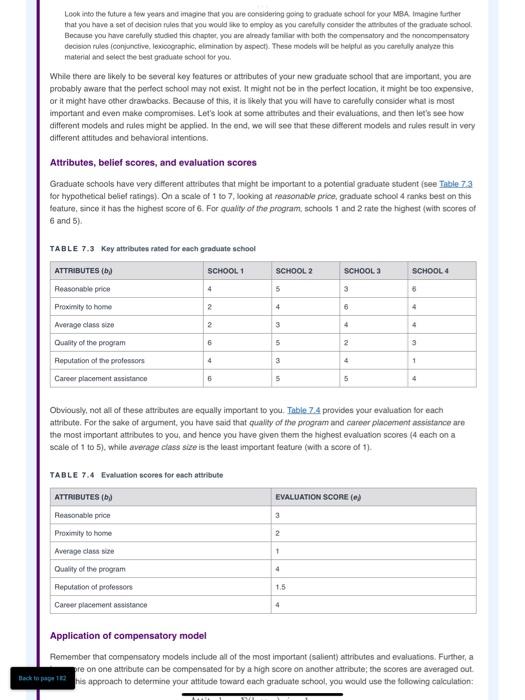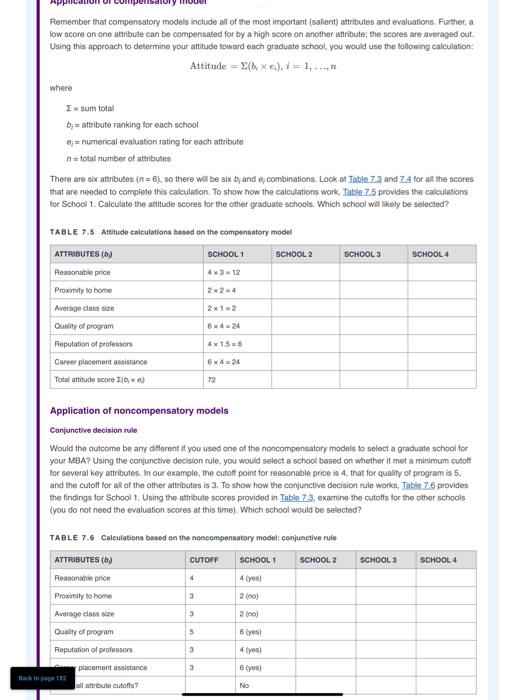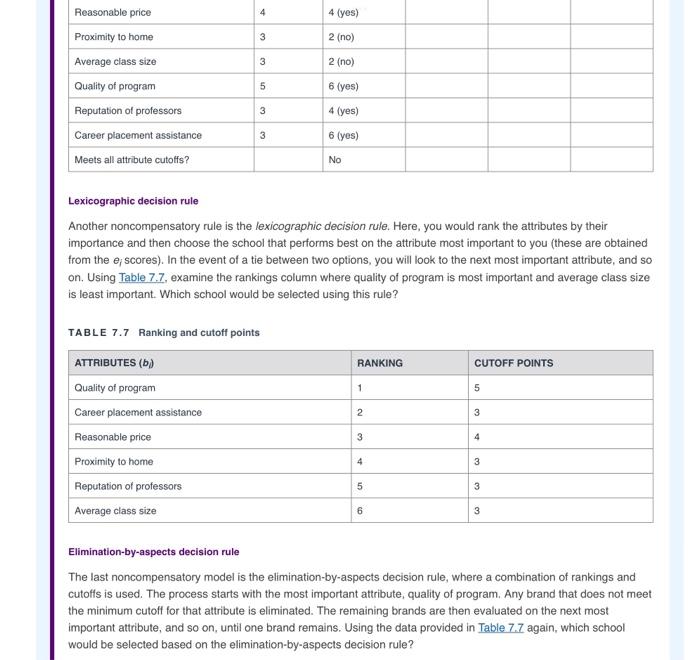Questions 1. Which school was selected for each of the four methods? Why did each of these methods provide different results? Generally speaking, how can marketers use this information to develop useful insights? 2. Based on your findings, what marketing recommendations do you have for colleges and universities? For students as they are considering different graduate school options? 3. The multiattribute approach in this case only included calculations for the expectancy-value model, not the TRA or TPB. How might the decision about your MBA change if you had also included assessments for subjective norms and perceived behavioral control? Look into the future a few years and imagine that you are considering going to graduate school for your MBA Imagine further that you have a set of decision rules that you would like to employ as you carefully consider the attributes of the graduate school Because you have carefully studied this chapter, you are already familiar with both the compensatory and the noncompensatory decision rules (conjunctive, lexicographic, elimination by aspect). These models will be helplul as you carefully analyze this material and select the best graduate school for you. While there are likely to be several key features or attributes of your new graduate school that are important, you are probably aware that the perfect school may not exist. It might not be in the perfect location, it might be too expensive, or it might have other drawbacks. Because of this, it is likely that you will have to carefully consider what is most important and even make compromises. Let's look at some attributes and their evaluations, and then let's see how different models and rules might be applied. In the end, we will see that these different models and rules result in very different attitudes and behavioral intentions. Attributes, belief scores, and evaluation scores Graduate schools have very different attributes that might be important to a potential graduate student (see Table 73 for hypothetical beliet ratings). On a scale of 1 to 7, looking at reasonable price, graduate school 4 ranks best on this feature, since it has the highest score of 6. For qunity of the program, schools 1 and 2 rate the highest (with scores of 6 and 5) TABLE 7.3 key attributes rated for each graduate school ATTRIBUTES (D) SCHOOL 1 SCHOOL 2 SCHOOL SCHOOL 4 5 3 Reasonable price Proximity to home Average class 2 4 6 4. 2 3 4 4 6 5 2 3 Quality of the program Reputation of the professors Career placement assistance 4 3 1 6 5 Obviously, not all of these attributes are equally important to you. Table 24 provides your evaluation for each attribute. For the sake of argument, you have said that quality of the program and career placement assistance are the most important attributes to you, and hence you have given them the highest evaluation scores (4 each on a scale of 1 to 5). while average class size is the least important feature with a score of 1). TABLE 7.4 Evaluation scores for each attribute EVALUATION SCORE (6) ATTRIBUTES (b Reasonable price 3 Proximity to home 2 1 Average classe Quality of the program 4 1.5 Reputation of professors Career placement assistance 4 Application of compensatory model Remember that compensatory models include all of the most important (salent) attributes and evaluations. Further, a pre on one attribute can be compensated for by a high score on another attribute the scores are averaged out Hack to this approach to determine your attitude toward each graduate school, you would use the following calculation: HIVI ON Remember that compensatory models include all of the most important salient) attributes and evaluations. Further, a low score on one attribute can be compensated for by a high score on another attribute the scores are averaged out Using this approach to determine your attitude toward each graduate school, you would use the following calculation: Attitude = (he), i = 1 +++ where sum total by attribute ranking for each school 0;= numerical evaluation rating for each attribute n = total number of attributes There are six attributes (n=6). So there will be six by and e, combinations. Look at Table 73 and 7.4 for all the scores that are needed to complete this calculation. To show how the calculations work, Table 75 provides the calculations for School 1. Calculate the attitude scores for the other graduate schools. Which school will likely be selected? SCHOOL 3 SCHOOL 4 TABLE 7.5 Attitude calculations based on the compensatory model ATTRIBUTES (5) SCHOOL 1 SCHOOL 2 Reasonable price 4x3-12 Proximity to home 2x24 Average class size 2 x 12 Ouvity of program 6x6 =24 Reputation of professors 4 x 1.56 Career placement assistance 6x24 Total attitude score byxa 72 Application of noncompensatory models Conjunctive decision rule Would the outcome be any different if you used one of the noncompensatory models to select a graduate school for your MBA? Using the conjunctive decision rule, you would select a school based on whether it met a minimum cutoff for several key attributes. In our example, the cutoff point for reasonable price is 4, that for quality of program is 5. and the cutoff for all of the other attributes is 3. To show how the conjunctive decision rule works, Table 7.& provides the findings for School 1. Using the attribute scores provided in Table 7.3. examine the cutoffs for the other schools (you do not need the evaluation scores at this time). Which school would be selected? TABLE 7.6 Calculations based on the noncompensatory model conjunctive rule ATTRIBUTES (0) CUTOFF SCHOOL 1 SCHOOL 2 SCHOOL SCHOOL 4 4 4 yes! 3 2 (no) Reasonable price Proximity to home Average classic Duality of program Reputation of professors 3 2 (0) 5 6 yel 3 placement assistance 3 6yes) Black top all attribute cutoffs No 4 4 (yes) 4 3 3 2 (no) 3 2 (no) Reasonable price Proximity to home Average class size Quality of program Reputation of professors Career placement assistance Meets all attribute cutoffs? 5 6 (yes) 3 4 (yes) 3 6 (yes) No Lexicographic decision rule Another noncompensatory rule is the lexicographic decision rule. Here, you would rank the attributes by their importance and then choose the school that performs best on the attribute most important to you (these are obtained from the e; scores). In the event of a tie between two options, you will look to the next most important attribute, and so on. Using Table 7.7, examine the rankings column where quality of program is most important and average class size is least important. Which school would be selected using this rule? TABLE 7.7 Ranking and cutoff points RANKING CUTOFF POINTS 1 5 2 3 ATTRIBUTES (1) Quality of program Career placement assistance Reasonable price Proximity to home Reputation of professors Average class size 3 4 4 3 5 3 6 3 Elimination-by-aspects decision rule The last noncompensatory model is the elimination-by-aspects decision rule, where a combination of rankings and cutoffs is used. The process starts with the most important attribute, quality of program. Any brand that does not meet the minimum cutoff for that attribute is eliminated. The remaining brands are then evaluated on the next most important attribute, and so on, until one brand remains. Using the data provided in Table 7.7 again, which school would be selected based on the elimination-by-aspects decision rule? Questions 1. Which school was selected for each of the four methods? Why did each of these methods provide different results? Generally speaking, how can marketers use this information to develop useful insights? 2. Based on your findings, what marketing recommendations do you have for colleges and universities? For students as they are considering different graduate school options? 3. The multiattribute approach in this case only included calculations for the expectancy-value model, not the TRA or TPB. How might the decision about your MBA change if you had also included assessments for subjective norms and perceived behavioral control? Look into the future a few years and imagine that you are considering going to graduate school for your MBA Imagine further that you have a set of decision rules that you would like to employ as you carefully consider the attributes of the graduate school Because you have carefully studied this chapter, you are already familiar with both the compensatory and the noncompensatory decision rules (conjunctive, lexicographic, elimination by aspect). These models will be helplul as you carefully analyze this material and select the best graduate school for you. While there are likely to be several key features or attributes of your new graduate school that are important, you are probably aware that the perfect school may not exist. It might not be in the perfect location, it might be too expensive, or it might have other drawbacks. Because of this, it is likely that you will have to carefully consider what is most important and even make compromises. Let's look at some attributes and their evaluations, and then let's see how different models and rules might be applied. In the end, we will see that these different models and rules result in very different attitudes and behavioral intentions. Attributes, belief scores, and evaluation scores Graduate schools have very different attributes that might be important to a potential graduate student (see Table 73 for hypothetical beliet ratings). On a scale of 1 to 7, looking at reasonable price, graduate school 4 ranks best on this feature, since it has the highest score of 6. For qunity of the program, schools 1 and 2 rate the highest (with scores of 6 and 5) TABLE 7.3 key attributes rated for each graduate school ATTRIBUTES (D) SCHOOL 1 SCHOOL 2 SCHOOL SCHOOL 4 5 3 Reasonable price Proximity to home Average class 2 4 6 4. 2 3 4 4 6 5 2 3 Quality of the program Reputation of the professors Career placement assistance 4 3 1 6 5 Obviously, not all of these attributes are equally important to you. Table 24 provides your evaluation for each attribute. For the sake of argument, you have said that quality of the program and career placement assistance are the most important attributes to you, and hence you have given them the highest evaluation scores (4 each on a scale of 1 to 5). while average class size is the least important feature with a score of 1). TABLE 7.4 Evaluation scores for each attribute EVALUATION SCORE (6) ATTRIBUTES (b Reasonable price 3 Proximity to home 2 1 Average classe Quality of the program 4 1.5 Reputation of professors Career placement assistance 4 Application of compensatory model Remember that compensatory models include all of the most important (salent) attributes and evaluations. Further, a pre on one attribute can be compensated for by a high score on another attribute the scores are averaged out Hack to this approach to determine your attitude toward each graduate school, you would use the following calculation: HIVI ON Remember that compensatory models include all of the most important salient) attributes and evaluations. Further, a low score on one attribute can be compensated for by a high score on another attribute the scores are averaged out Using this approach to determine your attitude toward each graduate school, you would use the following calculation: Attitude = (he), i = 1 +++ where sum total by attribute ranking for each school 0;= numerical evaluation rating for each attribute n = total number of attributes There are six attributes (n=6). So there will be six by and e, combinations. Look at Table 73 and 7.4 for all the scores that are needed to complete this calculation. To show how the calculations work, Table 75 provides the calculations for School 1. Calculate the attitude scores for the other graduate schools. Which school will likely be selected? SCHOOL 3 SCHOOL 4 TABLE 7.5 Attitude calculations based on the compensatory model ATTRIBUTES (5) SCHOOL 1 SCHOOL 2 Reasonable price 4x3-12 Proximity to home 2x24 Average class size 2 x 12 Ouvity of program 6x6 =24 Reputation of professors 4 x 1.56 Career placement assistance 6x24 Total attitude score byxa 72 Application of noncompensatory models Conjunctive decision rule Would the outcome be any different if you used one of the noncompensatory models to select a graduate school for your MBA? Using the conjunctive decision rule, you would select a school based on whether it met a minimum cutoff for several key attributes. In our example, the cutoff point for reasonable price is 4, that for quality of program is 5. and the cutoff for all of the other attributes is 3. To show how the conjunctive decision rule works, Table 7.& provides the findings for School 1. Using the attribute scores provided in Table 7.3. examine the cutoffs for the other schools (you do not need the evaluation scores at this time). Which school would be selected? TABLE 7.6 Calculations based on the noncompensatory model conjunctive rule ATTRIBUTES (0) CUTOFF SCHOOL 1 SCHOOL 2 SCHOOL SCHOOL 4 4 4 yes! 3 2 (no) Reasonable price Proximity to home Average classic Duality of program Reputation of professors 3 2 (0) 5 6 yel 3 placement assistance 3 6yes) Black top all attribute cutoffs No 4 4 (yes) 4 3 3 2 (no) 3 2 (no) Reasonable price Proximity to home Average class size Quality of program Reputation of professors Career placement assistance Meets all attribute cutoffs? 5 6 (yes) 3 4 (yes) 3 6 (yes) No Lexicographic decision rule Another noncompensatory rule is the lexicographic decision rule. Here, you would rank the attributes by their importance and then choose the school that performs best on the attribute most important to you (these are obtained from the e; scores). In the event of a tie between two options, you will look to the next most important attribute, and so on. Using Table 7.7, examine the rankings column where quality of program is most important and average class size is least important. Which school would be selected using this rule? TABLE 7.7 Ranking and cutoff points RANKING CUTOFF POINTS 1 5 2 3 ATTRIBUTES (1) Quality of program Career placement assistance Reasonable price Proximity to home Reputation of professors Average class size 3 4 4 3 5 3 6 3 Elimination-by-aspects decision rule The last noncompensatory model is the elimination-by-aspects decision rule, where a combination of rankings and cutoffs is used. The process starts with the most important attribute, quality of program. Any brand that does not meet the minimum cutoff for that attribute is eliminated. The remaining brands are then evaluated on the next most important attribute, and so on, until one brand remains. Using the data provided in Table 7.7 again, which school would be selected based on the elimination-by-aspects decision rule










